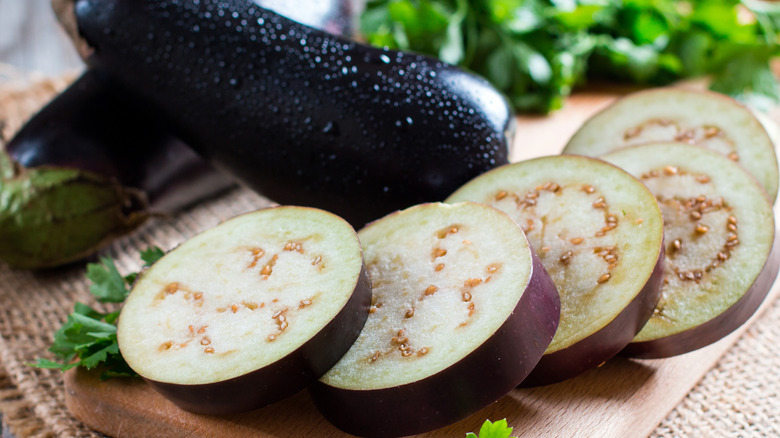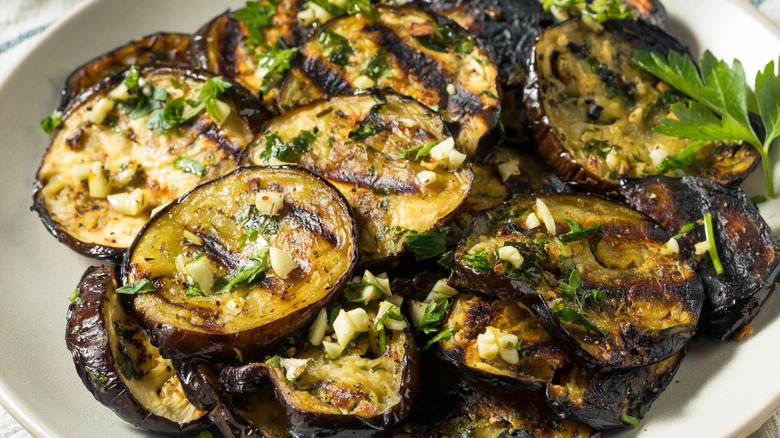Is It Necessary To Peel An Eggplant?
Picture this: You are standing in the vegetable section at the supermarket and you see some beautiful eggplants. You start daydreaming about that delicious, slow-cooked eggplant dish topped with hummus, fresh herbs, and pomegranate seeds you recently had at a local Mediterranean restaurant. Could you recreate that at home, or at least try to make something similar? Home cooks often wonder: Why is it that whenever you cook eggplant, it either turns out tough and bland — or even a bit bitter?
You may have been told by family members and friends that the key to cooking eggplant without those unpleasant results is to remove the skin. How could this be true, though, when you know the eggplant served at that Mediterranean restaurant had the skin still on? This begs the question: Is it necessary to peel an eggplant, or could leaving the skin on be the holy grail to eggplant perfection at home?
To peel or not to peel?
To get right down to it, no, it is not necessary to peel an eggplant. There are times when keeping the skin of the eggplant on can create a tough texture or bitter taste, which is why some people peel it off for ease. The skin, however, is completely safe and edible, and contains important nutrients, says Taste of Home.
Eggplant, also known as aubergine, is actually a fruit rather than a vegetable and is widely recognized for its deep purple, almost black color. This color comes from an antioxidant in the skin of the eggplant called nasunin, an anthocyanin, which helps preserve brain cell membranes and could help with memory loss and other neurological health concerns by combatting inflammation and promoting synaptic communication (via the British Journal of Nutrition). In addition, according to Taste of Home, eggplant can be used in a diet to help regulate blood pressure — also a benefit of the anthocyanins in its skin.
Although it may seem easier as a home cook to peel off the skin to avoid an unwanted texture or taste, one may be sacrificing many health benefits of the eggplant. So, what's the best way to cook an eggplant to perfection with the skin on?
Tips for cooking eggplant with the skin on
Although you can peel the skin, as mentioned, it is perfectly safe and beneficial to keep the peel of the eggplant on. Should you choose to reap the nutritional benefits, here are some tips and tricks to a delicious eggplant (skin and all) at home every time.
Ensuring that the skin of your eggplant cooks down perfectly starts while you're shopping. Larger eggplants typically have tougher skin, notes Fine Cooking. While shopping, try to choose smaller, younger eggplants with thinner skin that will cook down easily, adding great texture and flavor.
Once back at home and ready to start cooking, be sure to use plenty of fat, advises Bon Appetit test kitchen director Chris Morocco. The inside of the eggplant acts like a sponge and will soak up any liquid around it. To ensure that the skin of the eggplant cooks properly, you will need more fat than you may think. Add it slowly, though, as too much fat can result in a greasy dish. Practice makes perfect!
Lastly, cook the eggplant for longer than you think. According to Bon Appetit, when eggplant is done, it should turn "somewhat custardy." Undercooked eggplant is not ideal, but a fully cooked, melt-in-your-mouth one can be delectable. Cooking an eggplant for longer also helps break down any toughness or bitter taste in the skin, so you don't have to sacrifice taste and texture for nutrition.


